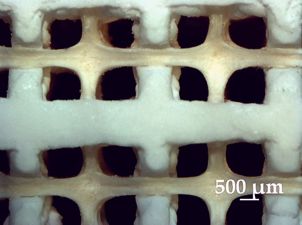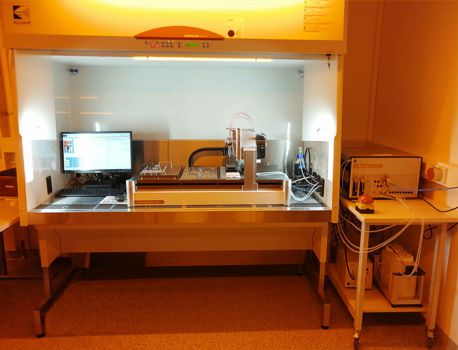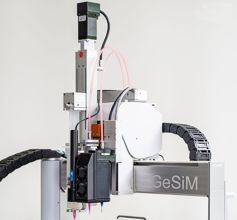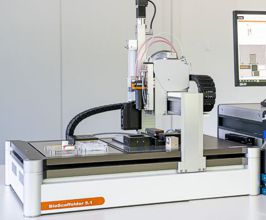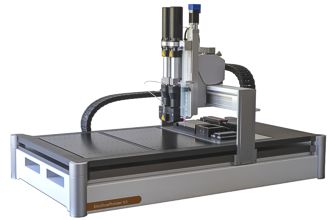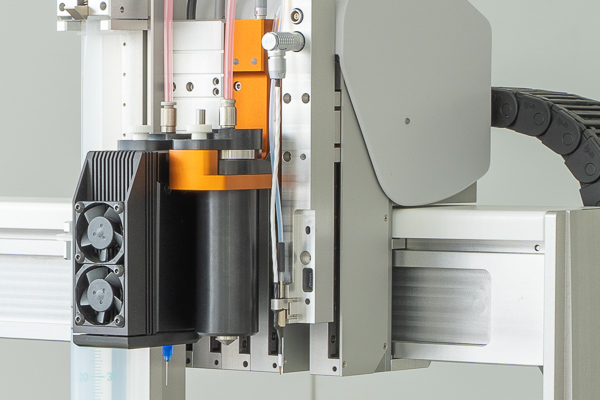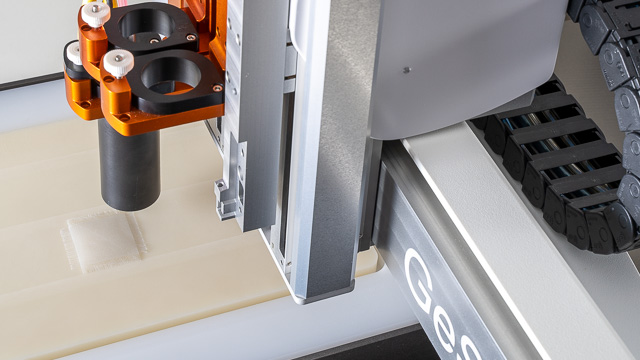


Additive manufacturing (AM) for tissue engineering (TE) and regenerative medicine combines biocompatible/biodegradable polymers with living cells. GeSiM 3D bioprinters can create bioscaffolds for cell growth or deposit layers of bioinks on implants or microfluidic objects. However, artificial bones, skin, organoids still not reach their originals made by nature. Research on this subject requires flexible lab equipment, compatible even with new tools and accessories still to be developed.
Our bioprinters offer this level of versatility. Pneumatic extrusion is on board of each GeSiM bioprinter, numerous tools can be configured with your order or added years later. The user interface fits into this philosophy and adapts to each individual combination of tools.
Most extrusion tools fit to all GeSiM instruments. The combination of 3D printed scaffolds with Nanolitre pipetting and microfluidics extends the field of TE to drug discovery, cell biology and more.
Smart Technology for Efficient Use
- Silent but smart XYZ-drives with Micrometer precision, individually Z-axes for print tools and optical components
- Decentralized units for printing, media control and computing save your precious space in biosafety cabinets and ensure superb heat dissipation
- Same software for all GeSiM bioprinters with easy to use CAD import
- UV-light sources of different intensity/ costs on the print head; camera systems
- Standard plastic cartridges as well as all Luer- lock nozzles can be used on all GeSiM bioprinters for 3d prints at room temperature
- Automatic alignment of all nozzle sizes to the building platform
- Print beds for SBS well plates with easy click fixation, temperature control and customized layouts available on request
GeSiM bioprinters are easy to operate in routine use:
Fully automatic adjustment of nozzles to the print bed (Left), the print bed size of BS5.1 (Right) fits to at least four SBS well plates or equivalent objects.
Nanolitre Pipetting
Tissue Engineering often raises interface and surface questions: How do cells adhere to artificial bones, implants and similar objects? What is the optimum scaffold geometry/ scaffold material to achieve appropriated cell adherence? Which cell line works, which doesn’t? Just throwing your ready-printed 3D object into a petri dish with cell suspension? – The Nanolitre pipetting module applies cells with spatial resolution during printing. Design and realization of complex artificial tissue with several cell types – partially applied to different parts of your 3D structure – becomes feasible.
The GeSiM Nanolitre Pipetting module allows up to 96 different cell suspensions or protein solutions for embedding into 3D structures during printing.
- CAD – based tethering of cells/proteins to parts of a 3D structure during printing,
- Volumes
- Onboard washing allows subsequent liquid handling of different species with one tool,
- Dispense volume ranges from 0.1 Nanolitre to Microlitres,
- Twin adapter for micro pipets enables parallel aspiration of two species with subsequent droplet mixing at the target position.
Refer to the tab PRINT TOOLS for technical information on available dispensers.
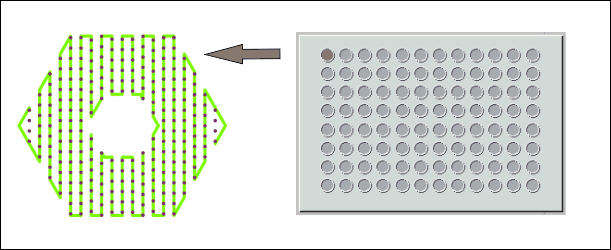
The pipetting module transfers up to 96 samples on 3D structures during printing
Sterile Working
Tissue Engineering assembles living cells to biopolymers. 3D printing shall be done quickly, safe and in a sterile environment. Physiological conditions have to be maintained to protect your particular cell lines which often incorporate a lot of labour and resources.
GeSiM Bioprinters always come without lid/ HEPA filters. Our instruments are designed to be placed in a professional Biosafety Cabinet (BSC) or at least in a laminar flow hood. The usual containments offer bench space for the manual preparation of bioinks immediately before 3D printing. It eliminates contamination risks when transferring your “living bioink” from another place to your 3D printer.
GeSiM collaborates with manufacturers of appropriated devices if you don’t have one in your lab.

The BS3.2 bioprinter in a TELSTAR Aeolus laminar flow hood
Instruments
BS3.3 Prime
The choice for beginners with potentially growing demands.
It is an attractively priced but complete bioprinter package:
- One temperature-controlled print head,
- LED UV-light, different wave lengths available,
- Pneumatic and mechanical extrusion,
- Syringe volumes from 10…50 Millilitres.
It prints a wide range of Hydrogels, Alginates and low-melting polymers like certain PCLs.
BS3.3
BS3.3 and it’s predecessors are in use for years in labs which paved the way for tissue engineering.
It is an individually configurable bioprinter for cutting-edge research. The range of available extrusion tools accepts almost any polymer of potential use in the field of TE. It combines highest flexibility with compact dimensions and fits in many popular biosafety cabinets.
BS5.1
It’s the perfect companion for large research teams, core facilities and service providers with 24/7 operation.
BS5.1 comes with extremely powerful linear motors. This bioprinter can run unrivalled systems for gradient mixing of thermoplastic biopolymers during the print, in addition to all other extrusion tools.
Applications at a Glance:
- 3D Printing of very different (Bio-)polymers (can contain cells)
- Design and print of porous – multi material – structures for tissue engineering
- Co-printing of hard (E.g. PCL/PLA) and soft (E.g. Alginate) biopolymers (Sequential printing, co-axial extrusion, Nanolitre pipetting)
- Functionalization of metal implants with soft polymer layers
- Printing of micro structures from biopolymers by melt electro spinning/writing
- Co-printing of two polymer melts through a gradient mixer
Highest Flexibility for a Changing World
GeSiM instruments incorporate highest modularity. Even when acquired for a particular project, additonal tools for upcoming projects are available at affordable costs.
Our budget line BS3.3 Prime comes with a fix combination of tools, whereas BS3.2 and BS5.1 can be configured almost arbitrarily. Here we show popular setups, please visit the preceding tab “Print Tools” for more information or download the brochure below.
Hardware upgrades mostly can be done without a service visit of GeSiM engineers (Limited for BS3.3 Prime). GeSiM permanently developes new tools/modules, probably fitting to your personal BioScaffold printer. The user software GeSiM Robotics reconfigures easily and reflects always the actual status when adding new hardware. Tool-related pieces of software can be added similar to the download of apps for your phone.
The GeSiM factory service is available for older BioScaffold printers as well as for retrofitting of BS3.3 Primes with fix configuration.
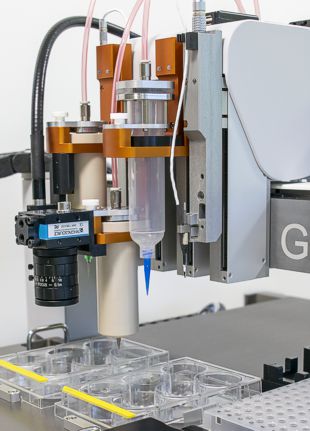
2x 10mL cartridge with heaters; Camera; 30 mL cartridge, Piezo Pipet (From left)
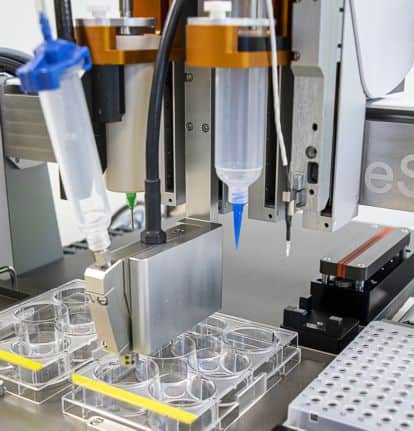
10mL cartridge with heater and UV head; Piezo valve (High viscosity); 30mL cartridge; Piezo Pipet (From Left)

HT-Extruder; 2x 30mL cartridges; Piezo Pipet (From left)
Particular applications may require tools for high pressure, high temperature, extremely thin strands and others:
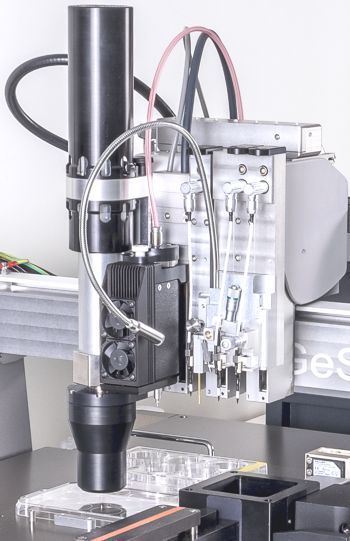
HT-Extruder; 10mL Peltier chiller; Z-sensor; Twin Piezopipet (From left)
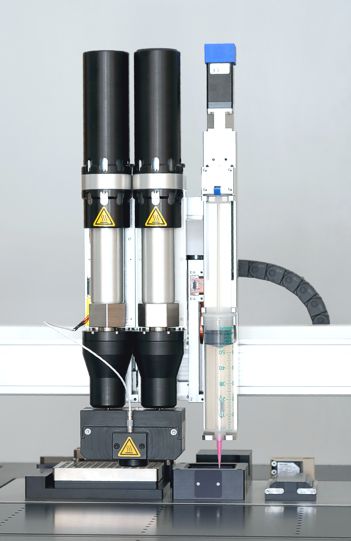
HT-Extruder 2x with gradient mixer; 50mL Extruder (From left)
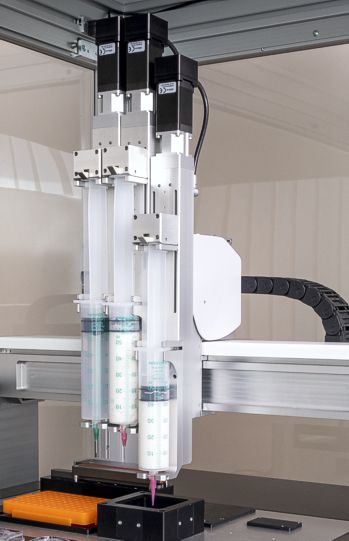
50mL Extruder 3x, for printing of large models and batch production
GeSiM Robotics
The user software of all our Bioprinters is called GeSiM Robotics. It is a flexible but intuitive software:
- Configuration and automatic alignment of print tools and print targets
- Quick test prints considering varying print parameters give best settings for a particular combination of cartridges, nozzles and biopolymers
- Optical monitoring of drop-on-demand pipets
- Replacement of cartridges/ nozzles on demand during a 3D print eliminates the risk of unsuccessful runs due to clogged nozzles and run out cartridges
- Planning and execution of batch processes (sequences) allows copies of a 3D structure or different separate 3D structures unattendedly.
Processing of External CAD Data
GeSiM Robotics supports STL and 3mf formats. An STL file describes triangulated surfaces in a three-dimensional Cartesian coordinate system. It is widely used for rapid prototyping, 3D printing and computer aided manufacturing.

3D models printed from STL files: Women breast model (left), bulbasaur (right)
The BioScaffold printer software defines internal scaffold- structures in between surfaces imported from a STL file. The 3mf format works similar but supports different objects in one file. It is the preferred data standard for multi-material scaffolds.
Print Tools
GeSiM BioScaffold printers can be configured by numerous tools for different extrusion principles as well as optical components, like cameras and UV lamps.
The range of tools is continuously developing; please contact us for the latest catalogue. Bioinks and polymers with complex physical properties can be tested in advance for an optimum system configuration.
Always on board: Pneumatic Extruders
The BS3.3 Prime comes with two, all other models will have three pneumatic extruders on board. Pneumatic extrusion is a gentle method to 3Dprint strands of bioinks. All printing parameters can be set individually for each extruder. The pneumatic extruders accept 10mL and 30mL cartridges, other sizes will follow.
Materials like Hydrogels and thermoplastics require temperature-controlled print heads. The following add-ons are optionally available for the 10ml cartridge extruder of each GeSiM bioprinter:
- Peltier cartridge chiller, 4°C to 80°C (left)
- Cartridge heater, RT to 190°C (middle)
- Nozzle heater (extends the cartridge heater), RT to 250°C (not shown)
Mechanical Piston Extruders
Powerful motor driven piston extruders extend the capability of the pneumatic extrusion system. Very stiff polymers as well as materials showing increased viscoelasticity often require higher pressure for accurate prints.
The High-Temperature Extruder (HT-Extruder) with max. pressure > 100 bar is an unrivalled tool when the pneumatic extrusion system reaches its physical limit. Precise piston movements at user defined speed ensure constant material flow, independent on the filling level of the cartridge.
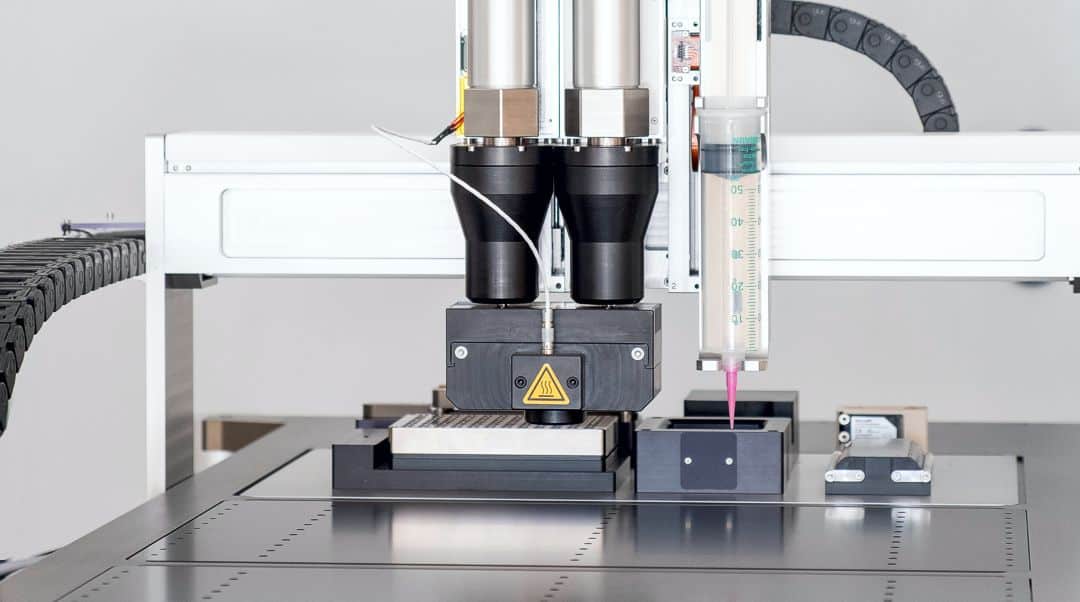
Piston Extruders on BS5.1: Pair of two HT-Extruders with gradient mixer (left); 50 mL extruder (right)
The High-Temperature Piston Extruder (HT-Extruder) prints thermoplastics like PLA (Polylactic acid) and ABS at temperatures up to 250°C. It comes with the stainless-steel cartridge as well as stainless steel nozzles. A two-zone heater compensates the temperature drop from the cartridge to the nozzle. Nozzles with diameter ranging from 100 Micrometers to 1,500 Micrometers are available for the HT-Extruder.
The Gradient Mixer (Available for BS5.1 only, left above) combines the outlets of two HT-Extruders with a special mixing head. It allows varying mixing ratios of two thermoplastic melts during one print.
The 50 mL piston extruder (right above) supports uninterrupted 3D printing of larger objects at room temperature. Adapters for smaller cartridges are available on request.
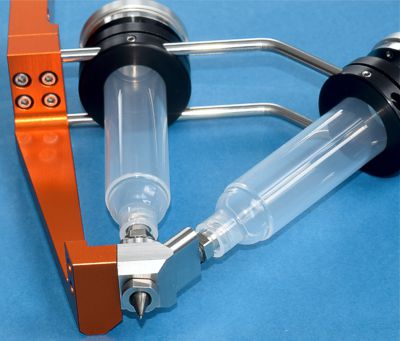
Core/Shell extruder for two materials
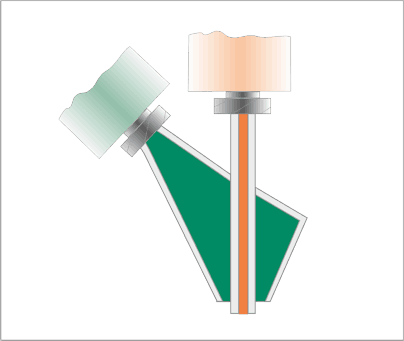
Schematic function
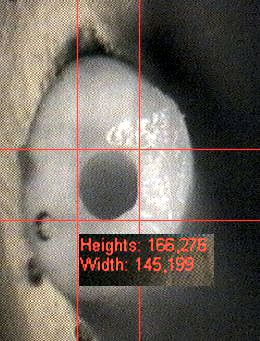
SEM image of C/S strand with empty core lane
Soft matrices like Hydrogels are cell friendly materials but hard to print into stable 3D structures. The combination with more stiff thermoplastic scaffolds may cause biocompatibility issues. The pneumatic C/S-extruder (Core/Shell-extruder) for the BioScaffold printers allows simultaneous printing of two materials with different properties in a coaxial arrangement. The tool features a pair of nozzles – an inner core nozzle, surrounded by the outer shell nozzle. The print parameters can be set individually for both channels in order to match properties of the respective bioinks. Nozzle diameters range from 100 Micrometre to 5000 Micrometre.
![Core/Shell strands with cells inside after 7 days cultivation (Bright field image) [1]](https://gesim-bioinstruments-microfluidics.com/wp-content/uploads/2019/07/CS_Bright_Field_Image.jpg)
Core/Shell strands with cells inside after 7 days cultivation (Bright field image) [1]
![Nuclei stained blue [1]](https://gesim-bioinstruments-microfluidics.com/wp-content/uploads/2019/07/CS_Stained_Cell_Nuclei.jpg)
Nuclei stained blue [1]
[1]Akkineni, T. Ahlfeld, A. Lode and M. Gelinsky: A versatile method for combining different biopolymers in a core/shell fashion by 3D plotting to achieve mechanically robust constructs, IOP Publishing Ltd., Oct 2016
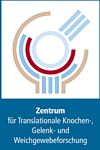 Centre for Translational Bone, Joint and Soft Tissue Research, Technische Universität Dresden
Centre for Translational Bone, Joint and Soft Tissue Research, Technische Universität Dresden
Nanolitre Pipetting Tools
The GeSiM bioprinters BS3.3 and BS5.x are available with the optional Nanolitre pipetting module. It transfers small liquid sample amounts from a 96 well micro titer plate to a defined locations on the target object during 3D printing.
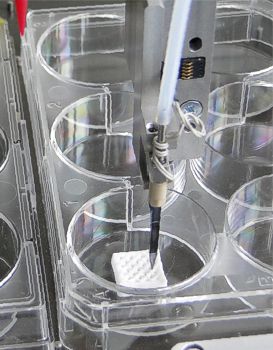
Piezo pipet on a 3D print
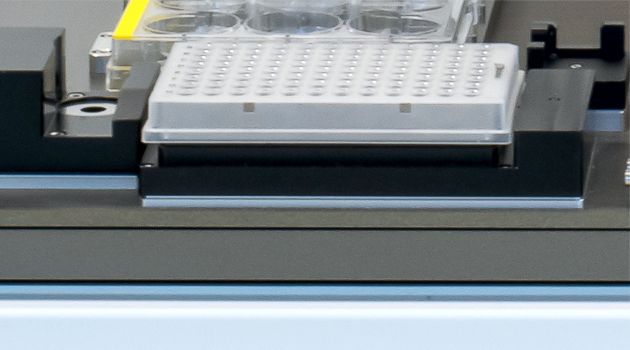
Source plater heater with 96 well plate; Drop camera (left)

Pair of piezo pipets on a swivel (Twin tip)
Pipets for different volume range are available:
- Passive needles for syringe supported displacement dispensing. The lowest dispense volume might be half a Microliter.
- The volume range between fifty Nanolitres and a few Microlitres is covered best by the solenoid dispense valve.
- Piezoelectric nozzles for free-flight micro drop dispensing (Viscosity limit around 10 mPa*s). The lowest dispense volume is in the range of 0.1 Nanolitres.
The innovative Twin-Tip-Pipettor operates two separate GeSiM piezoelectric nozzles on a swivel. For aspiration both nozzles dip into separate wells of a 96-well-plate. The droplets of both nozzles than hit each other and mix up on the target surface.
Heatable versions of the piezoelectric nozzles are available for liquids with higher but temperature dependent viscosity.
Curing/ Photopolymerization

Omnicure S1500 lamp on BS3.1; Optical fibre on the print head
Among others the GeSiM BioScaffold printers support the Omnicure S1500 UV lamp. GeSiM assembles the necessary optical fibre to the XYZ gantry. A special lens head attaches to one of the three cartridge holders.
An Opsytec UV-LED pen is the cost-attractive solution with a single wavelength.
Melt Electro Spinning-Writing (MEW)
The optional MEW module for the BioScaffold printers BS3.2 and BS5.x combines pneumatic extrusion and high-voltage induced fibre deposition for particular thermoplastic materials. Strand size and layer thickness come down below 100 Micrometres. Strand thicknesses of 10…20 Micrometres can be achieved from materials like PCL with a molecular weight of up to 50,000.

Micro-Mesh from PCL 50,000l 100 layers. The strand distance is 500 Microns (Left side) and 200 Microns (Right side)
In contradiction to Melt Electrospinning (MES) Melt Electrospinning Writing deposits each fibre in a regular manner. CAD geometries can be printed to a certain extent. GeSiM bioprinters combine MEW with pneumatic extrusion for a single print. E.g. grids at macro scale can be added to thin meshes made by MEW, achieving mechanical stiffness as well as good conditions for cell adhesion with the same 3D object.
Fused Deposition Modeling (FDM)
FDM belongs to the oldest methods for 3D printing. Instead of refillable cartridges filaments of defined diameter supply the print head in a continuous manner. On the other hand, available filaments are mainly made for mechanical engineering, with limited biocompatibility.
Optional available FDM print heads for the BioScaffold printers BS3.3 and BS5.1 extend the capabilities of our instruments beyond “pure bioprinting”.
Powder Pipet (Patent pending)
Tiny amounts of granular solid materials can be added to 3D prints by the new powder pipet: It’s kind of a vacuum tweezer with a defined pore chip or micro basket on the foot side. It aspirates either single grains or a few micrograms from a reservoir and dispenses it on a target. The foot area of the powder pipet is customized for a particular granule and application.
A particular biopolymer is usually available with very different compositions, molecular weight and physical properties (melting points, viscoelasticity). Please download the Tools at a Glance brochure for more information. GeSiM is ready for print tests with your own bioink/ biopolymer. Please contact us for arrangements.
Plasma Pen
The Plasma Pen (developed and manufactured by Nadir S.r.l.) is an atmospheric plasma jet that allows the ionization of argon gas by applying high voltage (HV) near the channel where the gas is flowing. It can be configured to each GeSiM bioprinter as individual tool.

Plasma Pen on BS5.1

Plasma treatment of a bone biopolymer scaffold during printing
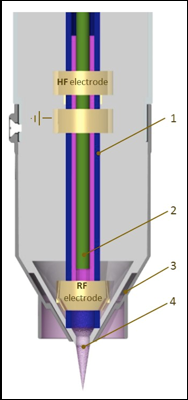
Schematic of Nadir Plasma Jet Module: Argon Channel (1), carrier gas or reactive gas capillary (2), cooling or shielding gas channel (3), plasma plume (4)
Applications:
- Activating and cleaning the whole object porosity
- Sterilization with oxidative plasma during polymer printing
- Functionalization with a proper chemical precursor without solvents
Benefits:
- Reductive or oxidative plasma can be used to clean surfaces, remove organic dirt or polymeric layers
- Surfaces can be activated to improve adhesion of cells, printed material or different melted materials
- Inlet capillary for the introduction of vapour and aerosol precursors allows deposition of functionalities, coatings and nanocomposites
 Forgalmazott termékeink gyártói - keressen gyártó szerint a logóra kattintva
Forgalmazott termékeink gyártói - keressen gyártó szerint a logóra kattintva


